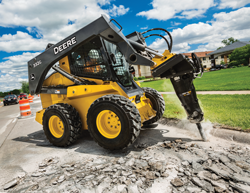Industry outlook -- Concrete tools and equipment
Silica dust control opens rental opportunities
OSHA requires dust control measures to limit worker exposure to silica dust created while cutting, drilling or breaking concrete.
By Clair Urbain
 |
| Having concrete tools ready for rent is valuable to contractors because they offer them the ability to work on a bigger project than usual or handle a busier than normal workload without having to buy more equipment. |
The world of working with concrete is changing as skilled labor becomes harder to find and increasing regulation, such as the OSHA silica dust exposure requirements, become more popular. We asked concrete tool and equipment experts how they view the changing world of working with concrete and how rental houses can adapt to those changes. Following is what they offer.
 |
Derek Betcher, marketing manager, Rental, John Deere
Rent equipment and attachments as a system
For every job where someone is pouring new concrete or moving dirt, there’s at least as many jobs where old concrete needs to be pulled out. The hammer is an indispensable tool. With the skilled labor shortage in the concrete industry, having the correct tools available is crucial to keeping job sites productive. Having concrete tools ready for rent is valuable to contractors because they offer them the ability to work on a bigger project than usual or handle a busier than normal workload without having to buy more equipment.
Integrating a hydraulic breaker or hammer onto a piece of equipment makes working with concrete faster and safer than a jackhammer. For example, John Deere hydraulic hammers are designed to be compact, allowing the operator to get into tough spots where other hammers can’t reach. We recommend rental companies offer integrated units as opposed to the hammer itself to ensure the attachment is properly rated for the machine and to minimize the risk of contamination. Cross-system contamination is the number one cause of hydraulic system failure.
Contractors are increasingly looking to machines with enclosed cabs to limit jobsite exposure to silica dust and to meet the new OSHA requirements. John Deere skid steers feature a best-in-class pressurized cab that limit dust exposure on the job site.
In general, a good rental operation provides basic pointers to the renter on safe operation, and keeps machinery properly maintained. The renter is responsible for following those instructions and operating the units safely plus following proper protocol to ensure the job doesn’t disturb underground utilities.
Utilization is a big driving factor for contractors who decide to rent equipment vs. owning it. Rental companies should help contractors realize that renting allows them to try equipment before they decide to purchase it. Renting allows contractors to tie the rental cost directly to a project instead of allocating ownership costs to the job, simplifying bookkeeping. Additionally, renting keeps maintenance the responsibility of the rental center so contractors can focus on productivity and profit.
 |
Todd Granger, vice president, American Pneumatic Tools
Rentals remove ownership burdens
The DIY audience is increasingly turning to concrete contractors to help tackle projects, which has diminished demand for rental concrete equipment by homeowners.
Still, concrete tool manufacturers put a significant amount of thought into the user experience, striving to create equipment that addresses the end user’s needs. We’re taking into account how our equipment is being used and how it can be modified to support the ever-changing industry.
New requirements is silica dust control have led to the development of dust suppression either with a water delivery system or dust collection through vacuum systems. To help end users prevent or minimize operator exposure to silica dust, rental centers are responsible for distributing instruction and education. Whether the equipment is delivered or picked up, the customer should have complete operator knowledge for each piece of equipment. In addition, the renting contractor must inspect equipment prior to each use to assure dust is being adequately controlled.
Increasingly, contractors are looking to rent equipment vs. buying it. Ongoing costs are the unspoken burden of owning machinery. Rental houses can ease any contractor’s mind by highlighting the fact that renting allows the renter to avoid regular maintenance fees. Contractors also bypass paying for any unexpected repair costs.
 |
Rob Johnston, vice president/business line manager, Air & Tools, Atlas Copco
Silica dust requirements means rethinking concrete tasks
Fewer DIY end users are tackling concrete work on their own. Instead, they are turning to concrete contractors to complete that portion of the project. This appears to have slowed demand for rental concrete equipment from a DIY perspective.
More than ever, concrete equipment manufacturers are developing machines to reflect the ideas and address end user pain points, considering how they currently use equipment and what additional features would they like to see.
One example is developing equipment and tools that accommodate the new silica dust requirements. One approach takes on dust suppression, which could be accomplished with water delivery system, or by using dust collection that uses a vacuum system to collect the dust as it is created. Both have benefits and limitations depending on the application—outdoors, inside, confined space, overhead -- there is not a one-fit-all type of solution.
To assure safe and productive use of rental concrete equipment, the responsibility of the rental house is instruction and education, while the responsibility of the renting contractor is inspection and proper use adhering to local and national codes, such as the OSHA silica dust standards. The rental house should make sure the customer is equipped with the knowledge and tools to safely operate the concrete equipment and meet these requirements. That can be accomplished by the rental house sending out an operator’s manual and information on the OSHA standard with every machine that is rented.
However, it is ultimately up to the contractor to meet the requirements and use the tools properly because they are liable on-site. The renting contractor should also be evaluating the equipment for working order, defects and potential safety hazards on a per-rental basis.
Savvy contractors see a major benefit of renting equipment is there aren’t scheduled maintenance costs or unexpected repair costs. Those responsibilities fall on the rental house. In essence, renting fixes the cost, allowing contractors to avoid hidden repair costs eating into their profit.
 |
Bob Shoop, product demonstrator/instructor, Caterpillar
Equipment attachments and technology improve accuracy and efficiency
Caterpillar provides skid steer attachments to make customers more efficient with concrete work. With the attachments, operators can get a finished product faster and more accurately, allowing them to save money and complete more jobsand create more revenue for their business. Caterpillar offers hundreds of attachments to help customers do their job faster and more efficiently, but Accugrade box blades, wheel saws, and cold planers can greatly increase productivity and accuracy.
One of the newest equipment advances at Caterpillar is the Cat box blade for site preparation. Designed for use with Accugrade technology, the dual slope-capable box blade it can use laser and GPS technologies to level and shape ground to within .25 inches. It allows operators to be more accurate in less time, which equates to fewer equipment hours and man hours and less fuel. The Cat Box Blade solution is available to buy or rent from your local Cat dealer.
Cat wheel saws for skid steer loaders, compact track loaders and compact wheel loaders are an excellent tools for sectioning roadways and trenching. Wheel saws can trench across asphalt and concrete with rebar to install new cables repair pipes, and remove concrete without impacting a large area of the surface. They are available from 3 inch to 10 inch widths and can cut up to 32 inches deep. On average, at 18 inches depth, a wheel saw can cut up to eight feet per minute in concrete.
Cat cold planers make concrete work easier and faster for customers. Six models of Cat cold planers offer solutions for rental and purchase customers. These cold planers have many features that increase production. They feature self-leveling and independently adjustable skid shoes, as well as afloat feature that allows the planer to follow the road contour. They can cut on average up to 24 feet per minute
Caterpillar also offers many complimentary attachments for use on concrete removal and placement. Vibratory rollers, to hammers with a variety of moils to break up and demo material, grapple rakes, brooms and multi-purpose buckets provide productive job site solutions Other attachment kits, such as debris guards, water tanks and water sprinklers, can help keep workers safe and meet job site regulations.
Rick Cacchioti, product manager, DeWalt
Cordless tool help compliance, efficiency
With the OSHA Final Rule on crystalline silica, our rental centers are driving compliance as a part of the rental process. For example, a user in the past would come and rent a pavement breakers and that was that. However, the new ruling creates add-on rental opportunities for a dust extractor and dust collection system. The OSHA fine for the user will be far greater than the cost of the both items and has allowed rental houses to tap into an additional revenue stream.
Users have also shown they prefer a complete system from one manufacturer. It provides them the assurance that they are compliant while making it easier for the rental outlets to provide the equipment needed to meet compliance requirements.
Cordless tools continue to make inroads in the concrete market. The DeWalt FlexVolt system has allowed users to cut the cord, untethering tools from generators by offering a high-performance, single-battery solution.
User application and experience drives the development process for DeWalt dust collection products Every effort is made to not change the way the worker works but instead change the tool to the way that they work
From an OSHA Final Rule on crystalline silica standpoint, it’s really on the user to assure compliance. Users expect the rental outlets to have the necessary systems in place on the tools that they rent. Most of the dust suppression systems are relatively inexpensive and fairly robust.
Michael Kennedy, senior vice president ,Rental, Hilti
Tool tracking systems help improve efficiency and compliance
Power tool manufacturers are helping customers comply with the OSHA silica standard by providing several Table 1 solutions. Another advance is in smart tools to help customers manage the use and maintenance of their tools easily. In these tools, electronics manage the tool’s system performance to ensure consistent performance across multiple power scenarios. For example, the Hilti DD250 core drill, which was introduced last year, can automatically regulate speed and torque of the machine depending on the base material in which it is drilling.
Active Torque Control (ATC), which can be found on many Hilti tool models, will shut off tools that spin too quickly due to the bit getting stuck in the base material, helping to protect the user from injury.
Increasingly, smart tools offer tool tracking, and Hilti now offers Hilti Connect, an app that allows customers to track usage and repair history directly from their phone of any Hilti tool. With their cell phone, they can scan a tool tag for this information. It allows customers to see a comprehensive repair history along with related items and documents, including OSHA and how-to videos that help support compliance. Similarly, Hilti’s On!Track software allows users to track all assets, including tools regardless of brand or manufacturer. It can also track training and certificates for each employee, produce alerts as renewals are needed, and easily generate reports. Because ON!Track’s primary focus is managing assets and equipment, the system will issue an alert if a piece of equipment is transferred to an individual who does not possess the proper training or licensing to operate it. On!Track can manage OSHA required documentation.
Th greatest change coming from theOSHA silica dust requirement is that most customers now need to purchase vacuums. Most Table 1 sections and power tool applications are compliant through the specifications of the dust collector, which most of the time is a vacuum. Unfortunately, these vacuums require more maintenance than a typical SDS-max rotary hammer or demolition hammer that are used in cutting drilling, cutting or demolition. Customers are finding the Hilti vacuums offer an automatic filter-cleaning mechanism which dramatically extens filter life and minimizes the need for routine filter changes.
To comply with the new silica standards customers should look for the systems and manufacturers who make their lives easier when it comes to use, maintenance, support, and proven compliance. More often than not, this will mean looking beyond just the system specifications to the who, how, and why benefits of picking one system over another.
Successful rental houses can meet the needs of the silica standard by sending equipment out complete, in good condition and repair. The units include the operator’s manual and any other information supplied by the manufacturer. I’s up to the renting contractor to use also use the tools per manufacturer recommendations.
Most contractors have a mix of rented and purchased tools and equipment. The contractor must assess the total cost of ownership when making a rent or buy decision. Hilti provides the service that contractors need regardless of how they choose to use Hilti products.
Russ Pierce, rental national account manager, Makita USA
Reduced weight, vibration increasingly popular
Rental customers want concrete tools with less weight and lower vibration that also get the job done faster and more efficiently. Makita Anti-Vibration Technology is more than a padded handle, it's an internal counterbalance system that significantly reduces vibration without compromise in performance. When it comes to gas-powered equipment, rental customers benefit with a one-can strategy, meaning no fuel mixing and they need only one can of straight gasoline for all power equipment. For these customers, Makita MM4 4-Stroke is the solution.
Resorts, schools and homeowner associations are becoming increasingly resistant to the noise and emissions of gas-powered equipment, so rental customers are shying away from using gas-powered equipment. Makita solves that need with its 18V X2 LXT (36V) power equipment. The system uses two 18V batteries in tandem for maximum power, speed and run-time but without the noise, emissions, maintenance and expense of gas-powered equipment. Makita offers the 18V X2 LXT (36V) system for cordless blowers, string trimmers, hedge trimmers and chain saws.
On the corded side, Makita created Anti-Vibration Technology and has an AVT-equipped hammer in every major class. This line-up includes the 70 lb. Breaker Hammer with Advanced Anti-Vibration Technology, which hits like an air hammer but without the added expense and hassle of a compressor and air hose.
For concrete cutting, the Makita MM4 4-stroke engine power cutter (EK7651H) is the world's first 4-stroke engine power cutter and requires no fuel mixing. Contractors tell us that piston failure due to improper fuel mixing is the number one cause of piston failure, which results in a potentially expensive repair cost. Makita MM4 four-stroke engine power equipment, including the EK7651H power cutter, requires no fuel mixing for added convenience. These units also have automatic engine decompression, which reduces pull-start force by 4 percent for easier starts. In addition, its pressure-compensated carburetor with vented choke plate offers optimum fuel delivery and reduces the occurrence of flooding during cold starts.
There is huge demand for more solutions that reduce concrete silica dust exposure to workers on the job site. Makita has an expanding dust extraction system with vacuums, accessories and attachments for use in concrete drilling, breaking, surfacing and cutting applications. These systems provide users the options needed to build an OSHA-compliant system for the job site. Rental houses can quickly find answers on Makita’s Solution Finder app at www.makitatools.com/dust-management)
Rental houses can help contractors understand the value of renting vs. owning tools by being educated in the total costs of ownership and by incorporating the newest and most innovative technologies into their rental fleets. A rental house having OSHA-compliant models and attachments available for rent is the best way to show the value of rental vs owning.
Andrew Pompei, key account manager, Rental Business, SkilSaw
Worker modifications drive new tool development
In the building industry, rules and regulations can significantly impact contractor’s needs and rental distributors must be ever-vigilant to changing demands to provide their customers with the information and products they require.
OSHA began enforcing its crystalline silica rule to protect workers from exposure to respirable silica dust. Many manufacturers have changed their offerings to comply with the rule and create safer work environments.
For example, before the silica dust ruling, workers would modify a standard worm-drive saw with aftermarket attachments, such as a skate plate, diamond blade or water kit. One of the greatest issues with aftermarket attachments was the inability to prove workers meet consistent and clear safety guidelines
Skilsaw engineers noticed how workers were modifying its saws and decided it was time to develop a fully integrated worm-drive saw for scoring concrete that met job site needs as well as complied with OSHA regulations. In 2016, the company introduced Medusaw, the first worm drive saw for concrete that offers a complete concrete scoring system with wet/dry dust management and other features to improve productivity.
Second-generation tools are another example of how tool advances are making working with concrete easier. The new Medusaw walk-behind unit meets users’ need for a complete, ergonomic solution for scoring concrete in larger applications where productivity is important.
Rental houses have tools and solutions that give contractors a convenient way to do their jobs at a cost-effective price, and both parties are responsible for ensuring safe tool use. Rental centers must perform routine maintenance to ensure the tools are in good shape and in compliance, and contractors must follow the appropriate safety guidelines when operating the rented tool.
Rental houses offer significant value for a contractor – because buying may not always be the right solution. Two common scenarios that bring contractors to rental houses include contractors who need a specialty tool outside their typical industry for a specific job, and contractors who need more tools than they own to complete a larger job or a high-volume request for a particular job.
If a contractor needs a specialty tool for a specific application, it’s more efficient and affordable to rent a tool from a rental house than it is to buy a tool that the contractor may only use once or twice.
If a contractor already owns a number of tools, but doesn’t have enough available for an unusually large job, it’s in the contractor’s best interest to rent the tool than it is to purchase additional tools he may not need later rather than turn down the job.
--end--
Copyright 2018 Direct Business Media. All rights reserved. Contact curbain@directbusinesmedia.com for permission to reprint or rebroadcast all or part of this article.









